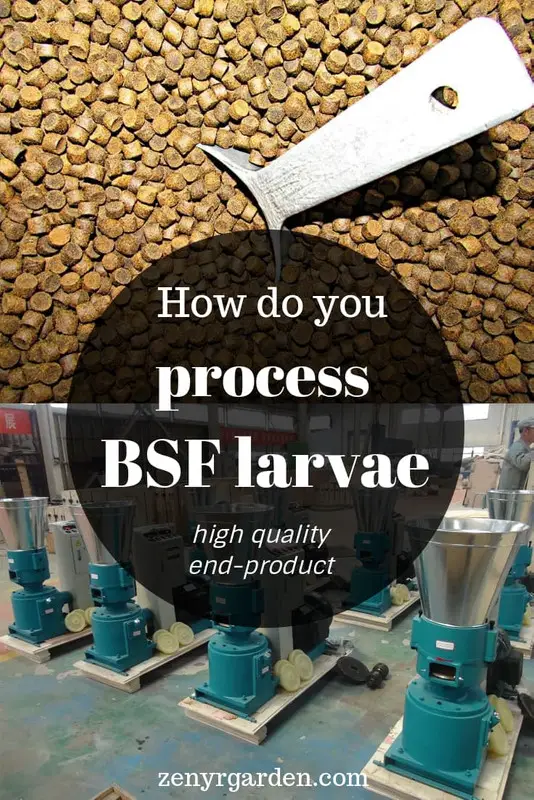Before we begin, may we say that the processing of black soldier fly larvae involves the killing of the grubs to be processed into food pellets. From an ethical standpoint, there may be different views on this topic. We won't discuss this here. If you're more okay with this, let's see some ideas together.
Step 1: Harvest the Larvae
A good point to harvest the larvae for further processing is when they're about 12 days old. This is when they are still more cream in body color & have not turned into darkened pre-pupae yet.
And it's at this point that the body of the larvae packs the maximum amount of proteins & fat. They are also at their peak weight, making it good for the final yield.
Let's see 3 different ways you can harvest the larvae:
#1. Sifting
To harvest the larvae, you can use a manual shake sifter to filter the frass (the remaining food pieces, larvae poop & exoskeletons) out from the larvae themselves. If the substrate is a bit wet & slurry, wait for it to air dry. It'll be easier to separate them when it's dry.
#2. Adding More Food on the Surface
This little trick is shared by Black Soldier Fly Colony. To get the larvae to come up from the feeding bed, add some more food on the top. After a while, when the majority of them have climbed up to the surface. You can use some netting or tools to gather them & scoop them out.
#3. Covering a Fabric Piece on Top
By covering a fabric piece on top of the feeding box, this may reduce the oxygen supply below. The larvae then, striving for survival, will naturally rise to the top. We can then grab the four corners of the fabric & harvest the larvae.
After collecting the larvae into one place, we can then begin:
Step 2: Rinsing the Larvae
After collecting the larvae, rinse them with water so the liquid & residue get washed off. Some facility weigh a few samples of larvae at this point. Some others don't. This is a good measure to get a rough number on how much yield we may be getting from how much larvae input.
The water discharged from this rinsing can actually be of value. Some people treat this as the raw manure. It still contains a lot of active microbes that can be later used as a worm (grub) tea or compost tea in the garden.
Like raw manure though, if we pour it directly into the soil at this stage, the high microbial activity may compete with the plants around for nutrients, therefore stunting plant growth.
So it's advisable to let it mature a bit more (about 1-1.5 months) before applying it. We may also keep this juice to sell as liquid fertilizer, attract pregnant female black soldier flies for next generation or sell it to bio-gas facility for fuel production.
Then, after rinsing the larvae and collecting the discharged water, you can start:
Step 3: Cleaning the Larvae
After rinsing the larvae, we can let them dry in coco peat or sand for one day. This helps clean the skin & gives them time to clean their guts. The larvae are still alive at this point. Doing this extra step helps with the end-product quality.
After that, with a batch of 5-10 kg of larvae, we can begin dipping them in boiling water for 1-2 minutes. This helps killing off any bacteria that may be sticking to the skin of the larvae & sanitizes the batch. Then, we can scoop them out & let them dry in the sun. This reduces the moisture content inside their bodies to about 10%. Which is good for storing the larvae for longer term.
According to Martin Tenywa, a bsf grower from Ento Organic Farm, whom we asked, it takes about 3 kg of fresh larvae to make 1 kg of dried larvae.
After the cleaning process is done:
Step 4: Processing & Pelletizing
If you're processing the BSF larvae for fish food, a good mix recipe can be:
- 35% BSF larvae
- 40% Cornmeal/soybean meal
- 25% Greens/carrots/cabbage
For pigs or chickens, we can mix in this recipe:
- 20 kg BSF larvae
- 20 kg corn
- 20 kg bran
- 0.5-1% salt
As the bodies of the larvae contain around 40-45% protein & 30% fats, if we don't press the fats out, then the oil may turn rancid. Which can lead to spoiling or shorter shelf life to only about 60 days.
To de-fatten the larvae, you can use an oil press or a centrifuge. More simply, we can add in some fermenting enzymes so they'll eat off some of the fat in the product.
If you're fermenting it, the process may take about 3-4 days. After de-fattening, the end larvae may have around 60% protein & 10% fat. This is a good high-protein end product that can be ready as-is to serve the market.
Also, just a quick note on the BSF oil. If you invest in an oil press machine, keep the oil because it can be used as a valuable ingredient for animal feed. The packaged oil can look something like this:
/larvae-feed-oil.jpg)
Once you're happy with the larvae, put them and the other ingredients in the grinder. A pellet mill machine works great in this case.
Depending on where you are located, the cost for one machine can be around $400-1000 per investment. It may look something like this or it may have a completely different design but does the same job. These machines make the process faster.
/small-pellet-mill.jpg)
After all that is done, the final step is to package your finished products & get it out to the market for your customers.
More On Drying the BSF Larvae
There is some more good information on drying the bsf larvae you might want to check out.
See this document for more details on drying the bsf: https://www.eawag.ch/fileadmin/Domain1/Abteilungen/sandec/schwerpunkte/swm/Practical_knowhow_on_BSF/bsf_factsheet_drying.pdf
Some other ideas include: sun dry, nut roasting machine, home microwave. Alternatively, a cheap/affordable option is place the larvae on a wooden platform, put a kaveera (clear plastic bag, polythene sheet) over the top. The sun can penetrate through the sheet and dry the larvae. You could regulate the heat with the sheet so the larvae are not overly dried.
Getting Started With Processing BSF
Hopefully this brief post has given you some ideas to get started with processing BSF larvae. The major part of this process is to make sure that we get a good, clean & nutritional product that customers can use to feed their animals, and that it can be stored for a long time to use for feeding in case of food shortage. Depending on their demand, we may decrease the fat amount in the product, which helps for longer storage.
The other by-products we may keep are the liquid juice from the rinsing step & the oil pressed out from the larvae bodies. So no part of the bsf is wasted. Let the juice mature a bit so it can be safely used as a compost tea. The oil can be packaged into little jars for animal feed oil. Some people also keep the shells (the cocoons, the chrysalis) of the pupae after they hatch to use as fertilizer. It's all your world of creativity and trial. Sample and trial is important. Hope you'll have fun, make a good amount of income & have more satisfied customers.
For more applications of the bsf frass (left-over undigested foods), you could check out:
Share or pin this post!


